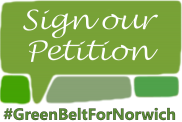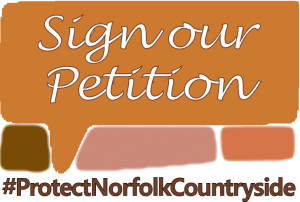Light Pollution
Light Pollution in Norfolk
Norfolk is one of England’s most rural counties and its dark landscapes and dark skies are a defining part of its rural character, deserving protection. Yet this special quality is under threat. Light pollution is caused by poorly designed or unnecessary light shining wastefully where it is not needed… and it is increasing.
A series of star count surveys carried out by CPRE, together with the Campaign for Dark Skies has shown that light pollution is spreading across the county and fewer and fewer areas in Norfolk can be considered truly ‘dark’. This increase in light pollution results from an acceleration in the rate of development and a proliferation of security lighting. View 2019’s Star Count map below to see how light pollution is affecting your area.
CPRE Norfolk actively campaigns to reduce light pollution in the Norfolk countryside. We work with planners, councils, architects, Norfolk Constabulary, the Highways Agency, lighting engineers, businesses and householders to ensure they are aware of the problems caused by unnecessary, inappropriate and excessive lighting and, by applying our recommendations, know how to take steps to address these problems.
Download CPRE Norfolk – Reducing Light Pollution Campaign Leaflet for more information on our work to reduce light pollution in Norfolk.
Download CPRE Norfolk – Light Pollution 10 Case Studies which gives ten specific examples of our engagement with the planning system and lighting bodies in Norfolk.
Download CPRE Norfolk – Security Lighting and Light Pollution which gives examples of how we are engaging with the issue of lighting and security.
Conference
In June 2015, CPRE Norfolk held a Light Pollution Conference at the University of East Anglia. The conference was attended by lighting engineers, lighting manufacturers, astronomers, policy makers, landscape specialists, Norfolk Constabulary, as well as representatives from parish, district and county councils. Bob Mizon from the British Astronomical Association’s Campaign for Dark Skies gave the keynote speech and an afternoon panel of local lighting decision makers debated issues around crime, lighting design, part-night switch offs, developments in LED technology and parish council initiatives. Presentations from the main speakers are below.
Bob Mizon, British Astronomical Association – Protect The Night: Light Pollution and Dark Skies
Emma Marrington, CPRE – Shedding Light: Local Authority Approaches to Lighting in England
David Hook, CPRE Norfolk – Protecting Dark Landscapes: Case Studies of Local Best Practice
Matt Worden, Norfolk County Council – Street Lighting in Norfolk
Peter Braybrook, North Elmham Parish Council – Street Lighting Running Costs
The Views Of Parish Councils
Early in 2015, CPRE Norfolk conducted a comprehensive survey of parish and town councils in Norfolk, to establish their views on street lighting and light pollution in the countryside. The survey results found that: – the majority of parish and town councils were concerned about levels of light pollution in Norfolk – security lighting, floodlighting and lighting from industry, farms, schools, pubs and garages were all identified as causing light pollution in the countryside – many parish and town councils were making regular recommendations on lighting when responding to planning applications, often using our Standard Light Pollution Clause (see below)
Download CPRE Norfolk Light Pollution Questionnaire 2015 – SUMMARY REPORT
Download CPRE Norfolk Light Pollution Questionnaire 2015 – FULL DATA REPORT
Planning Guidance
There are a number of policies in place, nationally and locally, that limit the impact of outdoor lighting on the environment. A key document in Norfolk is the Norfolk County Council’s adopted Environmental Lighting Zones policy and maps. This was proposed in 2002 and adopted by the Council in March 2003. CPRE Norfolk has its own ‘Standard Light Pollution Clause’ that it inserts into every planning application response it makes and many parish and town councils in Norfolk have also adopted this approach.
Download CPRE Norfolk – Policies on Light Pollution – a summary of local and national policies on light pollution
Download Norfolk County Council’s Environmental Lighting Zones Policy – Papers and Lighting Zones Map
Download Standard-Light-Pollution-Clause-pdf and Standard-Light-Pollution-Clause-word
How You Can Help Limit Light Pollution
We recommend that:
– All outdoor lights are fully shielded (enclosed in ‘full cut-off flat glass’ fitments so that no glass is visible beneath the lamp’s cover) and directed downwards (mounted horizontally to the ground and not tilted upwards).
– Outdoor lights are switched on only when needed (avoid ‘dusk to dawn’ lamps and use ‘PIR’ movement sensor lights or time switches instead).
– White light low-energy lamps are used (LED or fluorescent). Avoid orange or pink sodium lights which have an urbanising effect and are less energy efficient.
– Outdoor lights are only installed if really needed (the best way to prevent light pollution is to avoid the use of any outdoor lights).
Download CPRE Norfolk – Reducing Light Pollution Campaign Leaflet for images pertaining to best practice lighting.




